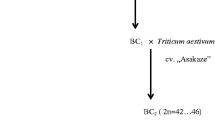Abstract
Recent achievements in the cytology and genetics of trisomics of barley are reviewed. The usefulness of new trisomic series in cultivated varieties is briefly outlined. Special reference is given to the comparison of trisomic series inH. spontaneum and in cultivated varieties including the spring type, two-rowed cultivar, Shin Ebisu 16, the only one in which a complete set was established.
Trisomics have been shown to be useful for verifying some doubtful results of previous linkage analysis, and to assign new mutant genes to particular chromosomes. The establishment of a new barley type with eight bivalents is reported in relation to the usefulness of trisomics in the experimental study of evolution in diploid plants.
Problems for future work were considered, such as: The establishment of a series of telocentric trisomics with the purpose of establishing more accurate linkage maps by designating more genes on each chromosome arm and by locating centromere positions on the maps. The analysis of enzymatic activity or other chemical proporties ascribable to specific individual chromosomes may be useful in the improvement of malting barley varieties.
Similar content being viewed by others
References
Dyck, P. L. &T. Rajhathy (1965). A desynaptic mutant inAvena strigosa.Can. J. Genet. Cytol. 7: 418–421.
Fröst, S. &G. Ising (1964). cytogenetics of fragment chromosomes in barley.Hereditas 52: 176–180.
Kamanoi, M. &B. C. Jenkins (1962). Trisomics in common rye,Secale cereale L.Seiken Ziho 13: 118–123.
Kattermann, G. (1939). Sterilitätsstudien beiHordeum distichum.Zeits. Ind. Abst. Ver. 77: 63–103.
Kerber, E. R. (1954). Trisomics in barley.Science 120: 808–809.
Kerber, E. R. (1958). A study of autotriploids and trisomics of common barley,Hordeum vulgare L. Ph.D. Thesis, Univ. Alberta, Edmonton.
Larter, E. N. (1966). Some fundamental studies on barley.Barley Newsletter,9: 66–67. Cited with the author's permission.
Larter, E. N. &H. Enns (1962). Some aspects of cytogenetic investigations with barley.Barley Newsletter 5: 39–40. Cited with the author's permission.
Nilan, R. A. (1964). The cytology and genetics of barley, 1951–1962.Res. Studies Monogr. Ser. Suppl., Washington State Univ., No.3: 278 pp.
Ramage, R. T. (1955). The trisomics of barley. Ph.D. Thesis, Univ. Minnesota. 90 pp. typed.
Ramage, R. T. (1960). Trisomics from interchange heterozygotes in barley.Agron. J. 52: 156–159.
Ramage, R. T. (1964). Chromosome aberrations and their use in genetics and breeding—translocations.Proc. Ist Intern. Barley Genet. Symp. 99–115.
Ramage, R. T. (1966). Genetic mechanisms for the production of male sterile plants.Barley Newsletter 9: 3–8. Cited with the author's permission.
Ramage, R. T., C. R. Burnham &A. Hagberg (1961). A summary of translocation studies in barley.Crop. Sci. 1: 277–279.
Robertson, D. W., G. A. Wiebe, R. G. Shands &A. Hagberg (1965). A summary of linkage studies in cultivated barley,Hordeum species. Supplement III, 1954–1963.Crop. Sci. 5: 33–43.
Sears, E. R. (1952). Misdivision of univalents in common wheat.Chromosoma 4: 535–550.
Sears, E. R. (1954). The aneuploids of common wheat.Univ. Missouri Agr. Res. Bull. 572: 1–58.
Sinha, R. P. (1967). Recombinagenic effect of certain chemicals applied to the genusHordeum. Ph.D. Thesis, Univ. Manitoba, Winnipeg, Manitoba.
Takahashi, R. &J. Hayashi (1966). Inheritance and linkage studies in barley. II. Assignment of several new mutant genes to their respective linkage groups by the trisomic method of analysis.Ber. Ohara Inst. Landw. Forsch. 13: 185–198.
Takahashi, R., J. Hayashi &U. Hiura (1966). Inheritance and linkage studies in barley. III. Linkage studies of the gene for fragile stem-2 and orientation of linkage map on barley chromosome 5.Ber. Ohara Inst. Landw. Forsch. 13: 199–212.
Takahashi, R., J. Hayashi &S. Yasuda (1957). Four genes in linkage which are inherited independently of the markers in the known seven linkage groups in barley.Nogaku Kenkyu (Agr. Res.) 45: 1–10.
Takahashi, R., T. Tsuchiya &I. Moriya (1964). Heritable mixoploidy in barley. III. On a dwarf mutant from a cultivar, Taishomugi.Nogaku Kenkyu (Agron. Res.) 50: 123–132.
Tsuchiya, T. (1960). Cytogenetic studies of trisomics in barley.Jap. Jour. Bot. 17: 177–213.
Tsuchiya, T. (1962a). A new trisomic type in barley.Chromosome Inf. Serv. 3: 16–17.
Tsuchiya, T. (1962b). Tetrasomic plants in barley.Chromosome Inf. Serv. 3: 17–18.
Tsuchiya, T. (1963a). Chromosome consititutions in progenies of various cross combinations between 2x, 3x and 4x in barley.Barley Newsletter 6: 98–99.
Tsuchiya, T. (1963b). An evolutionary significance of a pericentric inversion in a barley trisomic for chromosome 6.Proc. XIth Intern. Cong. Genet. 1: 121–122.
Tsuchiya, T. (1964a). Chromosome aberrations and their use in genetics and breeding in barley — trisomics and aneuploids.Proc. Ist. Intern. Barley Genet. Symp. 116–150.
Tsuchiya, T. (1964b) Primary trisomics in a cultivated two-rowed barley variety, Shin Ebisu 16.Can. J. Genet. Cytol. 6: 246.
Tsuchiya, T. (1966a). Telocentric fragments in barley.Barley Newsletter 9: 62.
Tsuchiya, T. (1966b). A vernalization experiment with the wild variety,Hordeum spontaneum var.Transcaspicum. Barley Newsletter 9: 63–64.
Tsuchiya, T. (1967a). Further experiments on the vernalization of the wild barley variety,Hordeum spontaneum var.transcaspicum.Barley Newsletter 10: 102–103.
Tsuchiya, T. (1967b). Cytogenetics of a telosomic trisomic type, Bush.Barley Newsletter 10: 103.
Tsuchiya, T., (1967c). Establishment of a trisomic series in a two-rowed cultivated variety of barley.Can. J. Genet. Cytol. 9: 667–682.
Tsuchiya, T. (1969). Cytogenetics of a new type of barley with 16 chromosomes.Chromosoma (Berl.)26: 130–139.
Walker, G. W. R., J. Dietrich, R. Miller &K. Kasha (1963). Recent barley mutants and their linkage. II. Genetic data for further mutants.Can. J. Genet. Cytol. 5: 200–219.
Most of the papers cited in Table 1 were given inNilan (1964) andTsuchiya (1964a).
Author information
Authors and Affiliations
Additional information
Contribution No. 163 of the Department of Plant Science, University of Manitoba.
Based on an address given at the Sixth American Barley Workers' Conference held at the University of Manitoba, Winnipeg, Canada, October 17–20, 1966.
Rights and permissions
About this article
Cite this article
Tsuchiya, T. Status of studies of primary trisomics and other aneuploids in barley. Genetica 40, 216–232 (1969). https://doi.org/10.1007/BF01787352
Received:
Issue Date:
DOI: https://doi.org/10.1007/BF01787352




